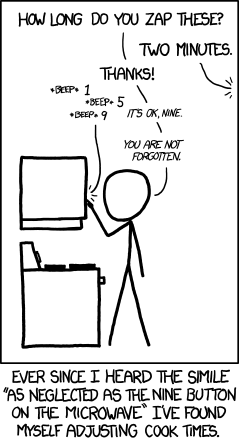I have a problem. Pun intended.
Posted by David Zaslavsky on — CommentsOMG I missed an XKCD!
This was posted a couple months ago, but I don’t remember seeing it until yesterday. The really interesting part is the title text:
FYI: If you get curious and start trying to calculate the time adjustment function that minimizes the gap between the most-used and least-used digit (for a representative sample of common cook times) without altering any time by more than 10%, and someone asks you what you’re doing, it’s easier to just lie.
Sure, it is easier to lie, but where’s the fun in that? Half the point of being a geek is watching the looks of confusion develop on other people’s faces when you start talking about your hobby. But don’t tell them I said that ;-)
No, the more interesting part of this title text is the problem it poses. Naturally, as soon as I read it, I had to figure out how to derive this optimal time adjustment function.
The easiest way to derive something is, of course, to look it up. And the XKCD forum thread for this comic yielded the dirt, so to speak. Tallys Yunes, an operations research expert at the University of Miami, has written a blog post describing just how to do that, for some representative values. His method is not exceptionally fancy, just setting up a constrained optimization model by brute force and then letting Excel go to town on it, but then that’s usually what it takes for this kind of problem. And, I mean… mmm, solutions.
Of course, as a physicist, I would want to look for an analytic solution. But that seems like it would be really hard, given the central role integers and their digits play in this problem. So I don’t expect that I’ll be devoting myself to figuring that one out any time soon.
Besides, I’m still working on the velociraptor problem.
